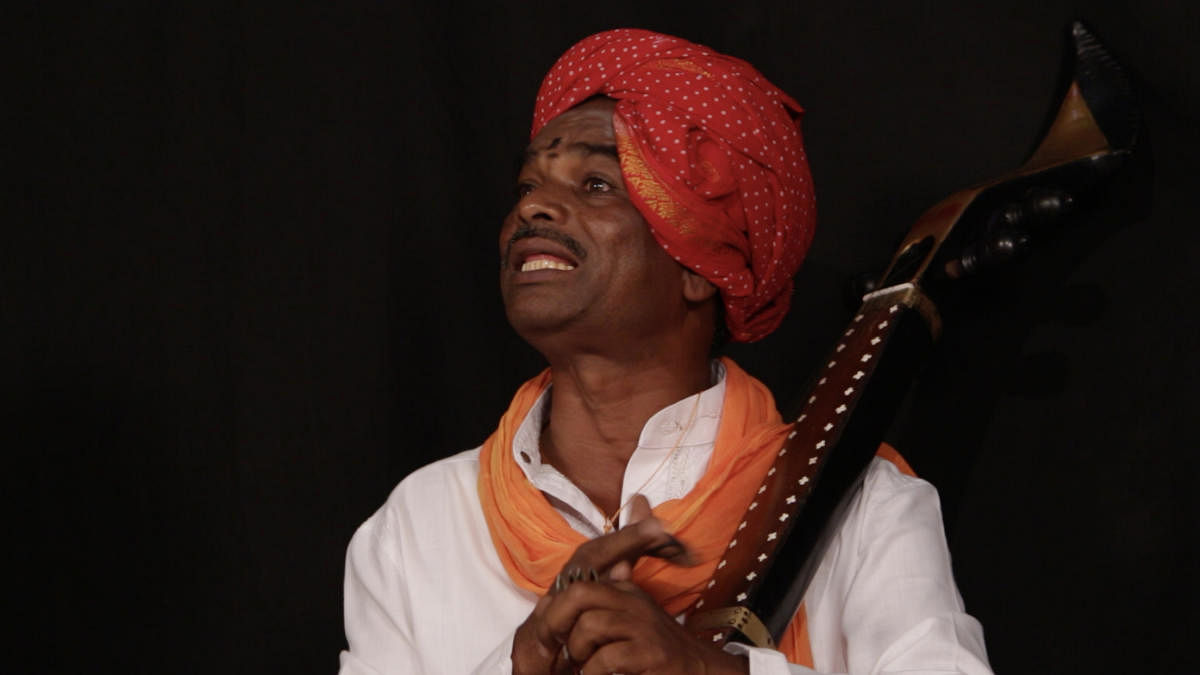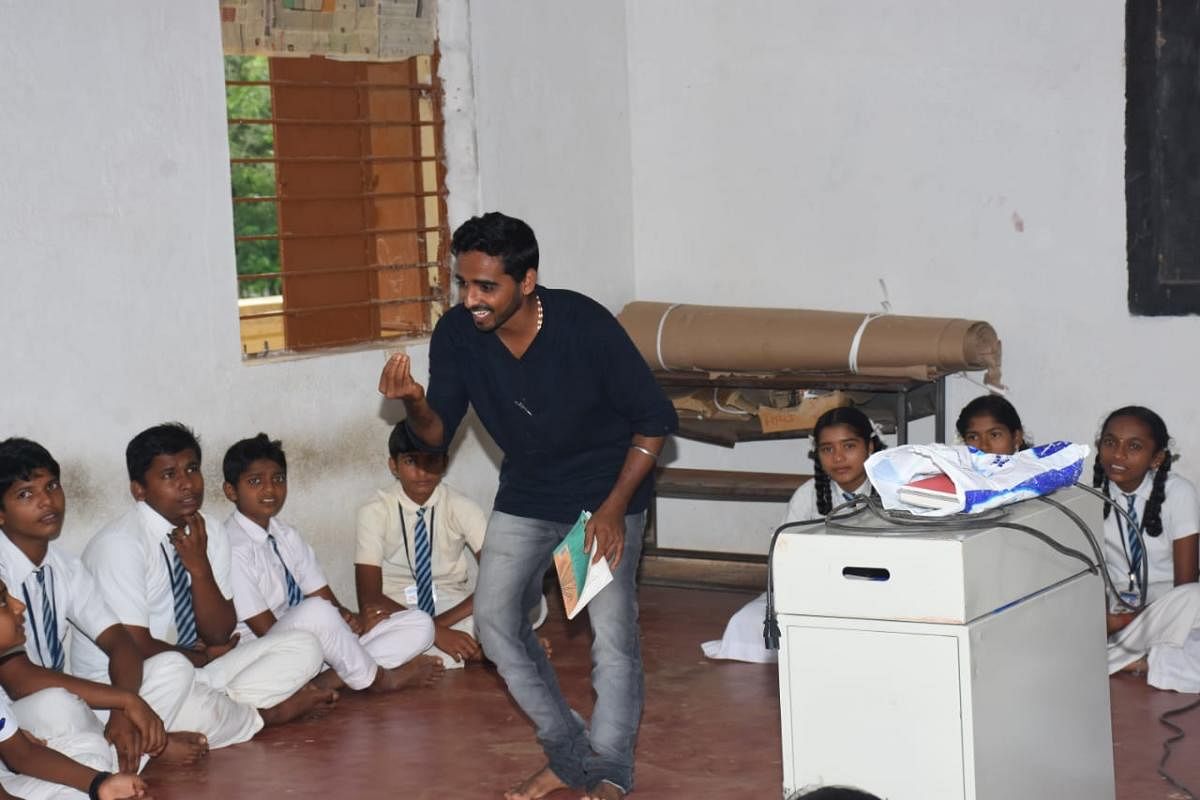

From songs that reflect the emotions of a mother seeing off her daughter after the wedding to the high-pitch Dollina Padagalu, folk music is a rich repository of Karnataka’s culture, tradition and language.
There are several efforts to preserve this art form and take it beyond the rural scene.
Coming from Tambuganahatti village in Tumakuru district, young folk artiste and writer Mohan Kumar N has documented around a thousand folk songs, especially Kadu Gollara, Kolata, Gane and Sobana Padagalu over the last decade, and is also teaching it to students across the state.
Having learnt it from his grandmother and mother, he visits every hatti (hamlet) in his home district and collects these songs, which will otherwise soon fade away.
“Teaching through music helps students grasp various aspects of life which textbooks often fail to convey. These folk songs deal with a variety of subjects like the local food, dress and village culture and propagate moral values,” says Mohan Kumar who is currently working as a resource person for the ‘Kali-Kalisu’ project of the India Foundation for the Arts.
He says these folk songs have been helping Kannada thrive as it makes language learning interesting. They not only encourage students to improve their vocabulary but also use the language in a more figurative manner.
“Unlike present-day songs which have hybrid words, folk songs use a chaste language.
Many of them have extracts from epics and great poetry, and some words date back centuries. However, we are losing them due to disuse. By teaching folk songs, we can rejuvenate our language,” he adds.
Raising awareness
Moved by the regressive practices that exist in their hattis even to this day, Mohan Kumar is also trying to bring in a social change through folk art. Through Karnataka Kadugolla Samskrutika Trust that he set up, he is raising awareness and busting myths, like those related to menstruating girls and women during child birth.
Far away from Tumakuru, Sumitra, another young woman from Mugalihal in Yaragatti taluk of Belagavi district has pulled off a silent coup, by entering the domain of Dollina Padagalu (Halumatha Hadugalu) which were mainly sung by men.
Inspired by her uncles who used to perform Dollina Padagalu, Sumitra learnt these songs when she was in Class 7 and continued right until into her college days.
“Usually, women do not perform Dollina Padagalu as these high-pitch songs need a lot of energy and are performed overnight. But I wanted to carry forward the tradition,” says Sumitra who has also trained around 20 to 25 girls from Vijayapura, Muddebihal and surrounding areas.
Dollina Padagalu is a mixture of songs and narratives and has two sets of people who converse (like question and answer) over a topic surrounding the principles of Shiva Sharanas, puranas or other social issues. They are sung during festivals and fairs and attract crowds due to their interesting language.
“Unlike some folk songs which have remained the same over the centuries, the narratives in Dollina Padagalu are based on contemporary topics also and so, we have to always come up with something new. For this, we need creative insight, presence of mind and also intrinsic vocabulary,” says Sumitra, who also composes the songs for her performances in Kannada.
Facing the huge, unbridled crowd at fairs and festivals is another big challenge for Sumitra but her desire to promote the folk art enables her to persevere.
In Mysuru, the Arivu Trust, along with a few other organisations, has been working to revive the folk art of the Neelagararu who mainly perform in districts like Chamarajanagar, Mandya and Mysuru.
They have been documenting the songs for the last four years and have collected/ documented up to 30 to 40 hours of audio.
They have also documented the life of Neelagararu who are professional religious singers, mostly from backward communities. Their songs are mostly dedicated to Manteswamy, the deity of their clan.
“The songs by Neelagararu are quite melodious and have a refined language. Many of the native Kannada words used by them are unique and are nearly extinct. These nuances of language are worth learning,” said Dr Manohar of Arivu, stressing the need to save this folk art.
The internet as a tool
Inspired by the folk arts in his family and his village, 31-year-old Revanasidda Dyamugol took a different route to introduce them and their art to the world.
A BEd graduate, Dyamugol who hails from Mylara village in Indi taluk of Vijayapura district, shoots the videos of Dollina Padagalu, Rihayat Padagalu, Gi Gi Pada and others performed at fairs and other occasions and uploads them on YouTube.
Started in 2017, his YouTube channel currently has around 7.5 crore viewers and 1.37 lakh subscribers. His viewership mainly includes those from districts like Belagavi, Vijayapura, Bagalkot, Kalaburagi, and even Maharashtra.
Interestingly, many of his followers from Maharashtra have begun learning Kannada to try and understand these songs better.
“My father used to sing Maddale Pada and I used to feel that we have to take such songs to the masses. But that had not been possible earlier. Now with the new technology tools, it is easier to reach the world,” says Dyamugol.
He shoots around two to three programmes a week in and around Vijayapura taluk. By doing so, he earns an income for himself and also gives these artists a platform to showcase their work.
“Initially, I used to contact the artists and shoot their performances but now, they themselves call and ask me to upload their shows on YouTube as it is improving their fan following,” says Dyamugol, who wants to set up a well-equipped studio and document other folk arts too.
All these efforts of documentation, while retaining the essence and charm of the form, are truly transforming these arts into ‘folk’ arts.